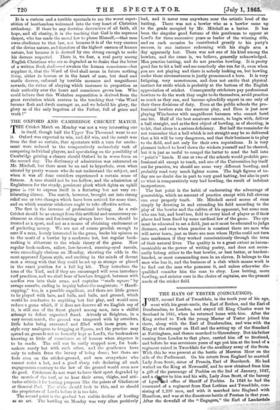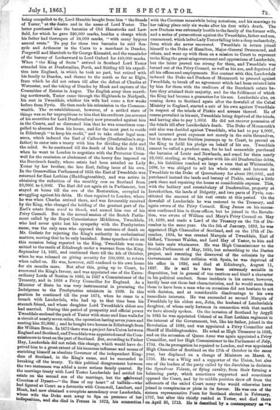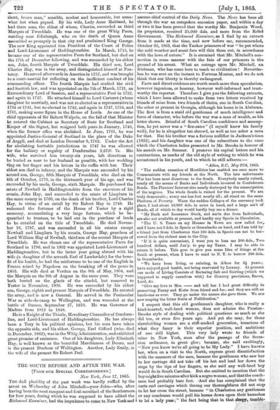THE HAYS OF TESTER (CONCLUDED).
JOEDT, second Earl of Tweeddale, in the tenth year of his age, went with his great-uncle, the Earl of Rothes, and the Earl of Dunfermline, to London, and stayed till King Charles went to Scotland in 1641, when he returned home with him. After the King retired to York the young Master of Tester joined him there, along with the Earl of Dunfermline, and was with the King at the attempt on Hull and the setting up of the Standard at Nottingham, and thence marched to Shrewsbury. But his father coming from London to that place, carried him of to Scotland, and before he was seventeen years of age put him at the head of a regiment raised in Tweeddale for the auxiliary army of the Scots. With this he was present at the battle of Marston Moor on the side of the Parliament. On his return from England he married Lady Jean Scott, sister of Francis, Earl of Buccleuch. He had waited on the King at Newcastli, and he now obtained from him a gift of the parsonage of Peebles on the 2nd of January, 1647, and a chillier to him and his wife, Lady Jean Scott, of the barony of Lynfted office of Sheriff of Peebles. In 1648 he had the command of a regiment from East Lothian and Tweeddide, con* slating of 1,200 men, and with it marched into England with flamilton, and was at the disastrous battle of Preston in that year. After the downfall of the "Engagers," the Earl of Lauderdale being compelled to fly, Lord Humbie bought from him "the Steads of Yester," at OA desire and in the name of Lord Yester. The latter purchased:also the baronies of Old Hamstocks and Law- field, for which he gave 220,000 marks, besides a charge which his father had thereupon of 24,000 marks, "with many bygone annual rents." To pay for these two baronies he sold Sea- syde and Arthmoor in the Cerra to a merchant in Dundee, Porgewill and Mareloth to Sir George Kinnaircl, and the remainder of the barony of Locharward to Lord Oxford for 440,000 marks. When "the King of Soots" arrived in Scotland Lord Yester attended him at Dunfermline, Perth, and Stirling till his expedi- tion into England, in which he took no part, but retired with his family to Dundee, and thence to the north as far as Elgin, from which he did not return till after the defeat of Charles at Worcester, and the taking of Dundee by Monk and capture of the Committee of Estates in Angus. The English army then march- ing northwards, Yester came through the Highlands to Neidpath, his seat in Tweeddale, whither his wife had come a few weeks before from Fyvie. He then. made his submission to the Common- Wealth. •The re-establishment, however, of a settled state of things was so far unpropitious to him that his creditors (on account of his securities for Lord Dunfermline) now proceeded against him in the Courts, and so distressed him that he was sometimes com- pelled to abscond from his house, and for the most part to reside in Edinburgh "to keep his credit," and to take other legal mea- sures, which induced the Earl of Callender (Dunfermline's step- father) to enter into a treaty with him for dividing the debt and the relief. So he continued till the death of his father in 1651, when he went to London to negotiate with the Protector Crom- well for the remission or abatement of the heavy fine imposed on the Buccleuch family, whose estate had been entailed on Lady Yester by her brother, the late Earl, failing issue of his own. In the Cromwellian Parliament of 1655 the Earl of Tweeddale VAS returned for East Lothian (Haddingtonshire), and was active in obtaining the reduction of the monthly cess on Scotland from 10,000/. to 6,000/. The Earl did not again sit in Parliament, but stayed at home till the eve of the Restoration, occupied in struggling against his debts. He then repaired to London, where he was when Charles arrived there, and was favourably received by the King, who changed the holding of the greatest part of the Earl's estate from ward to blench, and named him one of his Privy Council. But in the second session of the Scotch Parlia- ment called by the Royal Commissioner Middleton, Tweeddale, who had never quite lost his sympathy with the Presbyterian cause, was the only man who opposed the sentence of death on Mr. Guthrie for rejecting the King's authority in ecclesiastical matters, moving that he be only banished. Some speeches of his on this occasion being reported to the King, Tweeddale was com- mitted to the castle of Edinburgh under a warrant from the King, September 14, 1661, and continued there till the 4th of October, when he was released on giving security for 100,000/. to return when called on. He was, however, still confined to his own house for six months more. But after this, going up to Court, he recovered the King's favour, and was appointed one of the Extra- ordinary Lords of Session in 1666, in 1667 a Commissioner of the Treasury, and in 1668 a Privy Councillor for England. As a Minister of State he was very instrumental in procuring the Indulgence to the Presbyterian ministers in 1669. In this position he continued till the year 1674, when he came to a breach with Lauderdale, who had up to that time been his staunch friend, and whose daughter Lord Tweeddale's eldest son had married. During this period of prosperity and official power Tweeddale enclosed the park of Yester with stone and lime walls for a circuit of nearly seven miles, the operation lasting seven years and costing him 20,0001.; and he bought two houses in Edinburgh from Sir. William Bruce. In 1672 there was a project for a Union between England and Scotland, andTweeddale was appointed one of the Com- missioners to treat on the part of Scotland. But, according to Father Hay, Lauderdale did not relish this change, which would have de- prived him to a great extent of his immense influence and means of enriching himself as absolute Governor of the independent King- dom of Scotland, in the King's name, and he succeeded in breaking off the treaty. To this political disagreement between the two statesmen was added a more serious family quarrel. By the marriage treaty with Lord "Fester Lauderdale had settled his estate on the second son of the marriage, but theeip iebr eta" Countess of Dysart—" the Bess of my heart" of ballads—who had figured at Court as a favourite with Cromwell, Lambert, and Monk, had now obtained a complete ascendency over Lauderdale, whose wife the Duke sent away to Spa on pretence of her indisposition, and she died in France in 1672,. his connection with the Countess meanwhile being notorious, and his marriage to her taking place only sir weeks after his first wife's death. The new Duchess was extremely hostile to the family of the former wife, and a series of persecutions against the Tweeddales, father and son, commenced, which ledto LadyYester falling into a deep melancholy, from which she never recovered. Tweeddale in return joined himself to the Duke of Hamilton, Major-General Drummond, and others, and went up with them on a mission to Court to represent tothe King the great misgovernment and oppressions of Lauderdale, but the latter premed too strong for them, and Tweeddale was turned out of the Privy Council, as well as his son, and deprived of all his offices and employments. Not content with this, Lauderdale induced the Duke and Duchess of Monmouth to proceed against Tweeddale, to break off an agreement which had been entered into by him for them with the creditors of the Buccleuch estate be- fore they attained their majority, and for the fulfilment of which the King had become a guarantee for his son. Lauderdale also, on coming down to Scotland again after the downfall of the Cabal Ministry in England, started a snit of his own against Tweeddale in respect of the teinds of Pinkie and arrears thereof. He of course prevailed in his suit, Tweeddale being deprived of the teinds, and having also to pay 1,000/. He did not recover possession of the teinds till after Lauderdale's death. The Duke of Monmouth's suit also was decided against Tweeddale, who had to pay 4,000/., and incurred great expenses not merely in the suits themselves, but in three or four fruitless journeys up to Court, to prevail on the King to fulfil his pledge on behalf of his son. Tweeddale cannot be called a prudent man, for he had meanwhile purchased the baronies of Lente and Newlands, and owed for them nearly 10,000/. sterling, so that, together with his old Dunfermline debts, &c., his liabilities reached so large a sum that at Whitsuntide, 1686, he was obliged to sell his whole estate and interest in Tweeddale to the Duke of Queensberry for about 280,000/., and purchased instead the lands and barony of Pinkie, making a little park there and repairing the house at considerable expense. This, with the bailiary and constabulary of Dunfermline, property at Inverkeithen, the lands of Delgetty, and two parts of Fyvie, con- stituted the amount of his real estate at this period. On the downfall of Lauderdale he was restored to the Treasury, and again sworn of the Privy Council. King James on his succes- sion confirmed him in these offices, but he joined in the Revolu- tion, was sworn of William and Mary's Privy Council on May 18, 1689, and. made a Lord of the Treasury on the 7th of De- cember in the same year. On the 5th of January, 1692, he was appointed High Chancellor of Scotland, and on the 17th of De- cember, 1694, he was created Marquis of Tweeddale, Earl of Gifford, Viscount Walden, and Lord Hay of Yester, to him and his heirs male whatsoever. He was High Commissioner to the Scotish Parliament of May, 1695, but subscribing to the Darien project, and resenting the disavowal of the colonists by the Government on their collision with Spain, he was deprived of his office in 1696, and died at Edinburgh, August 11, 1697. He is said to have been extremely amiable in disposition, but in general of too cautious and timid a character in his political conduct. Some incidents in his career, however, hardly bear out these last characteristics, and he would seem from these to have been a man who on occasions did not hesitate to act with decision, and at considerable disadvantage to his own immediate interests. He was succeeded as second Marquis of Tweeddale by his eldest son, John, the husband of Lauderdale's daughter, of whose early fortunes in connection with that match we have already spoken. On the invasion of Scotland by .Argyll in 1685 he was appointed Colonel of an East Lothian regiment in the interest of the Government, but, like his father, joined in the Revolution of 1689, and was appointed a Privy Councillor and Sheriff of Iletddingtonshire. He acted as High Treasurer in 1696, and on the accession of Queen Anne was again appointed a Privy Councillor, and her High Commissioner to the Parliament of July, 1704. On its prorogation he repaired to London, and was appointed High Chancellor of Scotland on the 17th of October in the same year, but displaced on a change of Ministers on March 9, 1705. He was a Whig and a supporter of the Union, but also one of the leaders of the party called by the Jacobites in derision the Squadrons Volante, or flying cavalry, from their forming a balancing party, which sometimes supported and sometimes opposed the Court, and by its middle position drew off from the adherents of the exiled Court many who would otherwise have joined in conspiracies or plots in its favour. He was one of the sixteen representative Peens for Scotland elected in February, 1707, but after this chiefly resided. at Yester, and died. there on. April 20, 1713. Ile is described. by & contemporary air 444
short, brown man," sensible, modest and honourable, but some- what hot when piqued. By his wife, Lady Anne Maitland, he had three sons, the eldest of whom, Charles, succeeded as third Marquis of Tweeddale. He was one of the great Whig Peers, residing near Edinburgh, who on the death of Queen Anne assembled so promptly in that city and proclaimed King George. The new King appointed him President of the Court of Police and Lord-Lieutenant of Haddingtonshire. In March, 1715, he became one of the representative Peers for Scotland, but died on the 17th of December following, and was succeeded by his eldest son, John, fourth Marquis of Tweeddale. His third son, Lord Charles Hay, was in the army, and distinguished himself at Fon- tenoy. Heserved afterwards in America in 1757, and was brought to a court-martial for reflecting on the inefficient conduct of his commanding officer. The fourth Marquis had studied the civil and Scottish law, and was appointed on the 7th of March, 1721, an Extraordinary Lord of Session, and a representative Peer in 1722, and again in 1727. He attached himself to Lord Carteret (whose daughter he married), and was not re-elected as a representative in 1731 or 1741, but re-elected in 1742, and again in 1747, 1754, and 1761, making some figure in the House of Lords. As one of the chief opponents of Sir Robert Walpole, on the fall of that Minister he entered the Cabinet as Secretary of State for Scotland and Keeper of the Signet, but resigned both posts in January, 1746, when the former office was abolished. In June, 1761, he was appointed Justice-General of Scotland in the place of the Duke of Argyll, and died at London December 9, 1762. Under the Act for abolishing heritable jurisdictions in 1747 he was allowed for the bailiary or regality of Dunfermline 2,672/. 7s. His wife, who survived him twenty-six years, left directions to be buried as near to her husband as possible, with her wedding ring on her finger and his letters in the coffin with her. Their eldest son died in infancy, and the Marquis was succeeded by his second son, George, fifth Marquis of Tweeddale, who died on the 4th of October, 1770, in the thirteenth year of his age, and was succeeded by his uncle, George, sixth Marquis. He purchased the estate of Newhall in Haddingtonshire from the executors of his cousin, John Hay, and succeeded to the estate of Limplurn in the same county in 1760, on the death of his brother, Lord Charles Hay, in virtue of an entail by Sir Robert Hay in 1748. He redeemed the fortunes of the House of Yester by a rigid economy, accumulating a very large fortune, which he be- queathed to trustees, to be laid out in the purchase of lands to be entailed on the title of Tweeddale. He died Novem- ber 16, 1787, and was succeeded in all his estates except Newhall and Limplurn by his cousin, George Hay, grandson of Lord William Hay of Newhall, third son of the second Marquis of Tweeddale. He was chosen one of the representative Peers for Scotland in 1796, and in 1802 was appointed Lord-Lieutenant of Haddingtonshire, but in the latter year going abroad with his wife (a daughter of the seventh Earl of Lauderdale) for the bene- fit of his health, he had the misfortune to be one of the English in France seized by Napoleon on the breaking off of the peace in 1803. His wife died at Verdun on the 8th of May, 1804, and the Marquis on the 9th of August in the same year. They were both buried on the glacis of the citadel, but removed to Yester in November, 1806. He was succeeded by his eldest son, George, eighth and present Marquis of Tweeddale. He entered the army, and is now a General. He served in the Peninsular War as aide-de-camp to Wellington, and was wounded at the battle of Busaco, September 27, 1810. He was Governor of Madras from 1812 to 1848.
He is a Knight of the Thistle, Hereditary Chancellor of Dunferm- line, and Lord-Lieutenant of Haddingtonshire. He has always been a Tory in his political opinions, but his sons have taken the opposite side, and his eldest, George, Earl Gifford (who. died in December, 1862), was in the Whig Administration, and exhibited great promise of eminence. One of his daughters, Lady Elizabeth Hay, is well known as the beautiful Marchioness of Douro, and is the present Duchess of Wellington. Another, Lady Emily, is the wife of the present Sir Robert Peel.
































 Previous page
Previous page